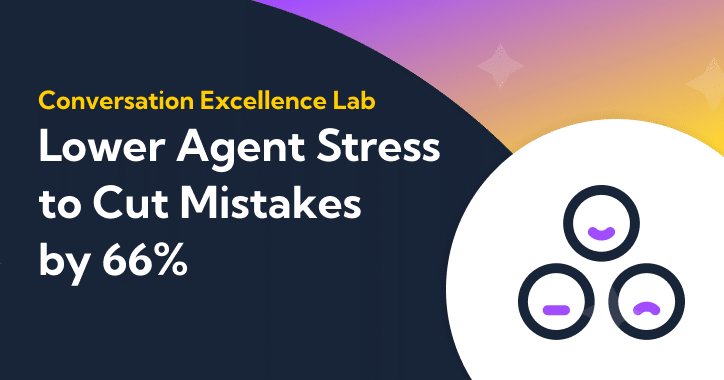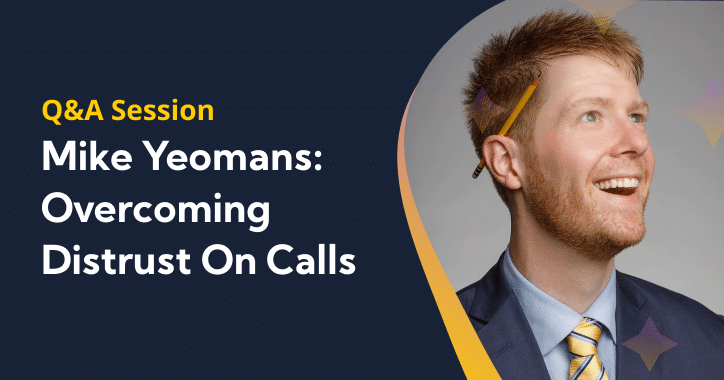Call scripts are used in contact centers of all shapes and sizes — across the industry, they are considered an easy way to help ensure all of a contact center’s agents are driving calls to the same goals.
But if you manage a center with hundreds or thousands of agents, then trying to keep everyone on the same script is challenging at best. How do you scale compliance as your agent population grows? How do you QA calls when it becomes infeasible to listen to a representative sample? These challenges, among others, lead to unique scripting issues at larger contact centers.
The Conversation Excellence Lab surveyed 567 agents from contact centers large and small to uncover the nuances in scripting across the industry.
What we found:
- Workers in contact centers with over 1,000 agents have the least effective scripts.
- The biggest contact centers have the lowest reported rate of script adherence, despite what their managers think.
- In addition to having the longest reported scripts, the largest contact centers have the least agent involvement in script writing.
What we think it means:
- As we reported on coaching, problems with script adherence scale with contact center size.
- Due to their size and a high rate of remote work, these agents feel the least connected to their managers.
- Agents in the largest contact centers feel the most disconnected from the purpose of their script.
Subscribe to future Conversation Excellence Lab reports below:
The Biggest Contact Centers Have 11% Less Effective Call Scripts
Our survey included agents from five different-sized contact centers:
- Less than 5 agents
- 5 to 20 agents
- 21 to 300 agents
- 301 to 1,000 agents
- 1,000+ agents
Out of all five groups, agents from companies with over 1,000 agents reported having the least effective scripts on a scale of 1-5 (3.19). By comparison, all other groups reported their scripts being moderately more effective (3.47 or above). Combined, centers with over 1,000 agents have 11% less effective scripts than centers with less than 1,000 agents.
Figure 1: Script Effectiveness By Contact Center Size
It’s interesting to note that the next largest centers, those with 301-1,000 agents, reported having the most effective scripts (3.65). Both groups had similar-sized respondent pools (8% and 9% of total respondents, respectively). This difference could be attributed to the range encompassed by the 301-1,000 group: contact centers that have 350 agents are much closer to the next smallest group while centers with 950 agents are much closer to the next largest group.
One possible explanation for the fact that contact centers with over 1,000 employees have lower reported script effectiveness is their high rate of remote workers. Nearly half of 1,000+ center respondents reported working remotely (48.8%).
Figure 2: Work Environment By Contact Center Size
As we discussed in our report comparing how in-person and remote agents use scripts, remote agents are the most likely to view their scripts as ineffective. Remote agents are not able to take cues from the agents’ around them or easily flag their managers over for feedback on best practices. As a result, they feel stuck to following their scripts verbatim.
Agents at The Biggest Contact Centers Avoid Their Call Scripts…
Alongside having the least effective scripts, contact centers with 1,000+ agents also reported the lowest rate of script adherence on a scale of 1-5 (3.40).
This makes sense given that agents from these contact centers are more likely to find their scripts ineffective. Meanwhile, contact centers with 301-1,000 agents have the second-highest script adherence rate (3.71), perhaps due to differences within the range of this category.
Figure 3: Script Adherence By Contact Center Size
A quick recap:
- Agents in the largest contact centers report the lowest script adherence.
- The largest contact centers also have the largest percentage of remote workers.
- We previously reported that remote agents are more likely to stick to scripts.
How do we reconcile these three facts?
First, let’s dive into the differences in adherence rates between remote, in-person, and hybrid agents working in the largest contact centers. We found the rates track with our previous findings: Remote and hybrid agents reported higher adherence rates (3.29 and 3.91, respectively) than their in-person colleagues (3.09).
Another factor could be that agents in the largest contact centers avoid their scripts because they believe their coworkers do the same. These agents reported the second-lowest rating on how much they believed their coworkers used their script (3.26).
Figure 4: Estimated Coworker Script Usage By Contact Center Size
As we claimed in our recent report, this points to the power of social proof. If new agents in big contact centers see more tenured agents dismissing their script, they will emulate that. And since agents in the largest contact centers also have a higher chance of being remote, the same issue we described previously is in play: if they don’t like their scripts, they aren’t able to bolster them with feedback and modeled best practices from other agents. They may grow animosity towards a prescribed tool without an avenue to fix it.
…Despite What Their Managers Think
Yet despite their admitted awareness of how little they and their coworkers use their script, agents in the largest contact centers have the highest reported ranking to the question, “On a scale of 1-5, how much of your call script does your manager believe you follow?”
Figure 5: Perceived Manager-Estimated Script Usage By Contact Center Size
This creates two situations:
- Agents in the largest contact centers feel the most physical and professional distance between themselves and their managers. This creates a distrust where agents assume managers don’t actually know what’s happening on calls.
- Since they know their coworkers are also using less of their scripts, this confirms their belief that the script isn’t helpful and managers aren’t setting them up for success on calls.
We asked our respondents, “On a scale of 1-5, how much do you agree with the following statement: I trust management to set me up for success with a strong call script.” Agents in the largest contact centers reported the lowest trust overall.
Figure 6: Trust in Management By Contact Center Size
By comparison, agents in the smallest contact centers had the second-lowest adherence rates and relatively lower trust in their managers, similar to agents in the largest contact centers. Agents in the smallest centers also believe their coworkers have lower adherence, similar to those in the largest centers. However, agents in the smallest centers reported a low rank for how much of their script their managers believe they follow. They also reported much higher script effectiveness. Finally, agents in the smallest contact centers had the highest rate of in-person work.
Taken as a whole, the data above supports our idea that in-person teams see scripts as a jumping-off point for calls, and are willing to sacrifice script adherence if it means using a better suggestion from coworkers or managers in the thick of a call.
Agents at the largest contact centers don’t follow their scripts because they don’t want to. But agents at the smallest contact centers don’t follow their script because they don’t need to — they feel more empowered to improvise and make calls on their own.
Agents at The Biggest Contact Center Have the Least Say in Their Call Scripts
One simple solution managers in the largest contact centers could use to encourage agents to trust their scripts is to involve them in writing and updating them. However, agents in the largest contact centers have the lowest reported involvement in this process on a scale of 1-5 (2.86). By comparison, contact centers with 21-300 agents reported the highest involvement (3.35).
Figure 7: Agent Involvement in Script Writing By Contact Center Size
Agents with the least involvement in script-writing are the most likely to want to change everything about their script. In addition, nearly a quarter of all survey respondents wanted to change the length of their scripts. With this in mind, it doesn’t help morale that agents in the largest contact centers report having the longest scripts.
Figure 8: Script Length By Contact Center Size
At this point, a dire situation is created for agents in the largest contact centers:
- They have the longest scripts but the least amount of input in what they say.
- They don’t trust their managers and feel the highest disconnect from them.
- In turn, they think their scripts are ineffective and avoid them more than any other group.
In 1,000+ agent contact centers, this situation is tough on morale. 2 out of 3 agents already wish they could change their scripts. Given the above conditions, it is likely that this animosity can build quickly for agents in large contact centers.
What Can Managers in the Biggest Contact Centers Do?
Managing a contact center with over 1,000 agents is an entirely different endeavor than managing a 10-person operation. With scale comes new challenges, but also new opportunities for improvement:
- Make time to ask your agents their opinions on their scripts. They’re the front-line of your organization and have some of the best insights into how customers react to what they’re saying.
- Build trust by talking to your agents about how their script was developed and the reasoning behind certain statements. Help them understand the decision-making process and any context that went into making the script. As redundant as it may seem, “telling it like it is” does wonders avoid employee pushback.
- Involve your agents in the script writing process. Ask them what pieces of their scripts they find highly effective and which parts they don’t. This allows them to feel a sense of ownership over their work — a proven strategy to increase buy-in.
- Encourage your agents to chat with one another and share best practices. This can be done informally on the floor, or for remote teams, through webinars hosted by experienced agents or designated meeting times to discuss new strategies.
Utilizing the tactics above will allow you to ease agent dissatisfaction, power script improvements, and pave the way for higher satisfaction and lower attrition among your workforce.
Sources
Balto. (2022, May 2). 2 Out of 3 Contact Center Agents Want to Change Their Script - Balto AI. RSS. Retrieved June 1, 2022, from https://www.balto.ai/research/why-contact-center-agents-want-to-change-their-script
Balto. (2022, May 31). Call Scripts in 2022: What In-Person, Virtual, and Hybrid Agents Really Think - Balto AI. RSS. Retrieved June 1, 2022, from https://www.balto.ai/research/call-scripts-and-remote-agents/
Balto. (2022, March 29). Contact Center Attrition: What Agents Want in 2022 - Balto AI. RSS. Retrieved June 1, 2022, from https://www.balto.ai/research/contact-center-attrition-2022
Balto. (2021, October 22) We Surveyed 500 Managers About Call Center Coaching. Conclusion: It’s Not Working. - Balto AI. RSS. Retrieved June 1, 2022, from https://www.balto.ai/research/call-center-coaching-manager-survey/
The Decision Lab. (2021, February 17). Social Proof - The Decision Lab. RSS. Retrieved June 1, 2022, from https://thedecisionlab.com/reference-guide/psychology/social-proof
Harvard Management Update. (2008, February 26). How to Win the Buy-In: Setting the Stage for Change - Harvard Business Review. RSS. Retrieved June 1, 2022, from https://hbr.org/2008/02/how-to-win-the-buyin-setting-t-1
Pickford, H. C. (2016, October 20). Psychological Ownership: Effects and Applications. Economics of Mutuality. Retrieved June 1, 2022, from https://eom.org/content-hub-blog/psychological-ownership
Cite this article
Balto. (2022, June 14) Why the Biggest Contact Centers Have the Least Effective Call Scripts - Balto AI. RSS. Retrieved from https://www.balto.ai/research/call-scripts-in-big-contact-centers






